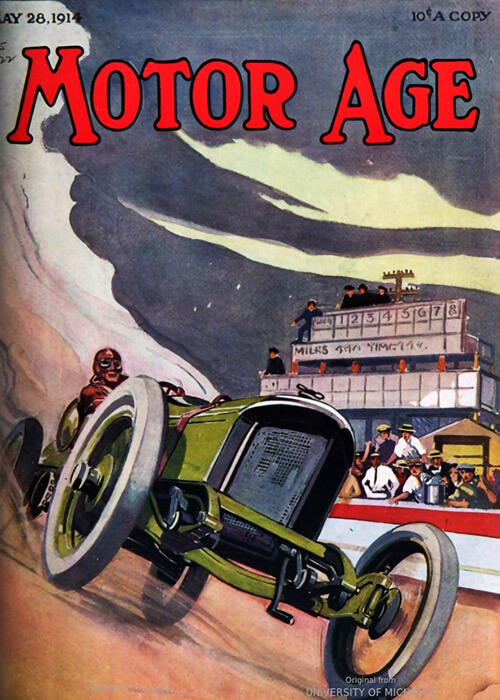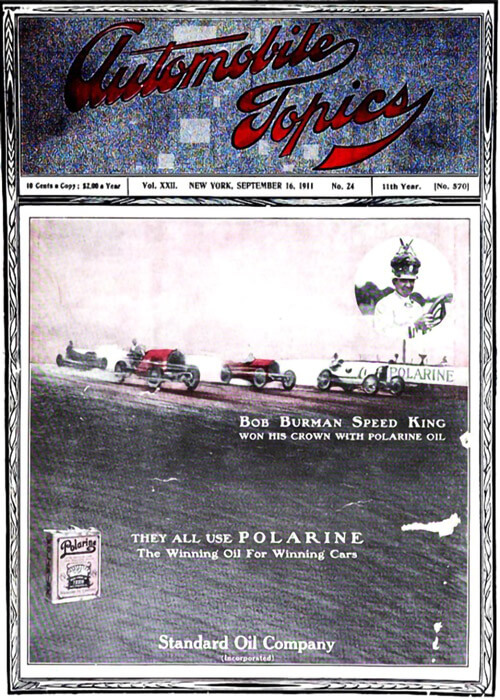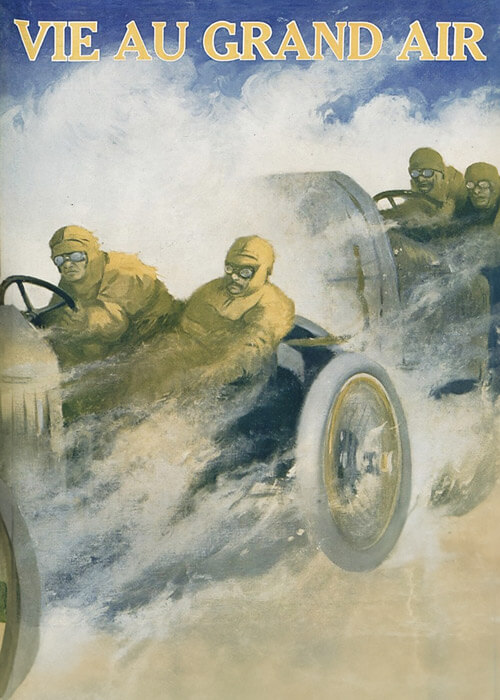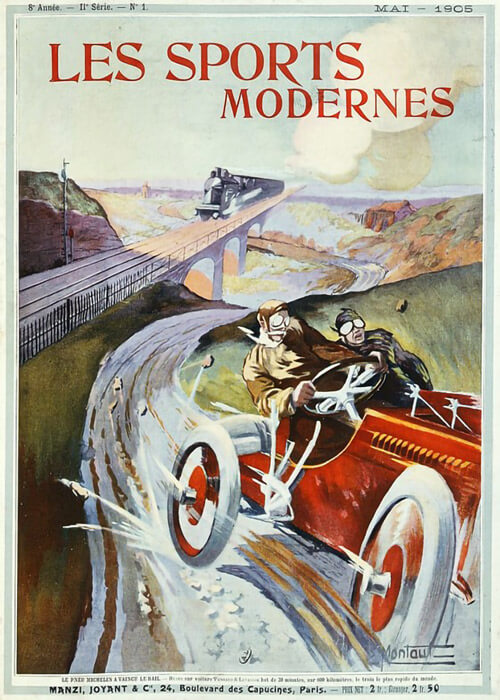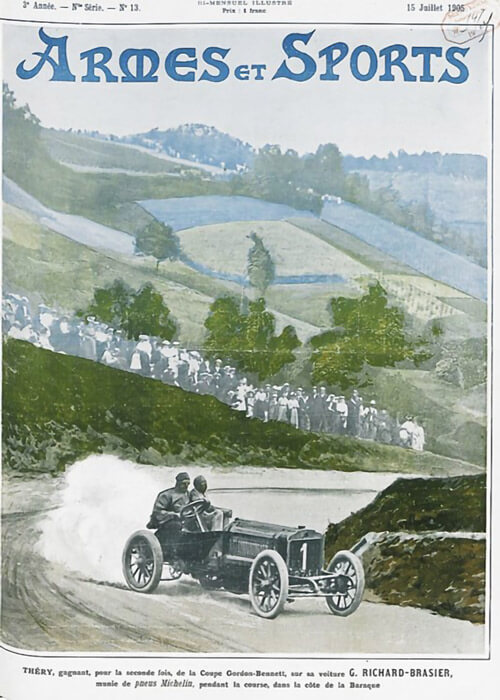How the first 500-mile Indianapolis race developped, in view of technical issues; inclusive a list with technical details of all participating cars.
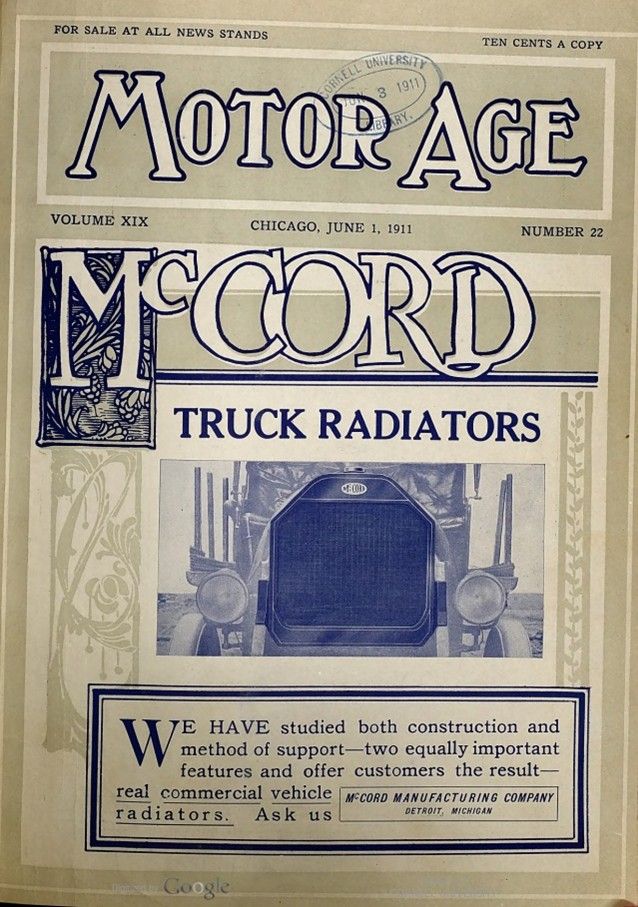
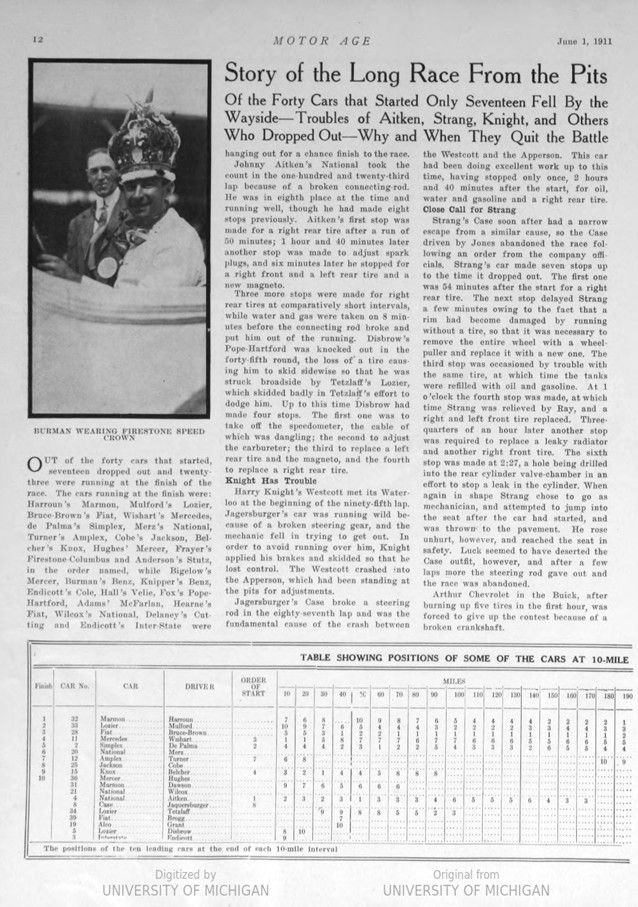
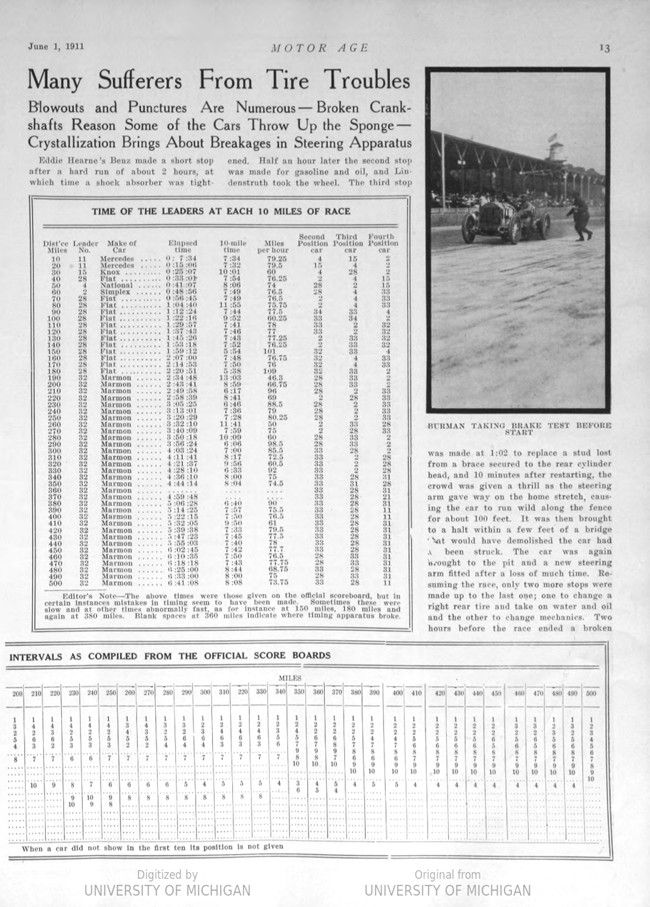
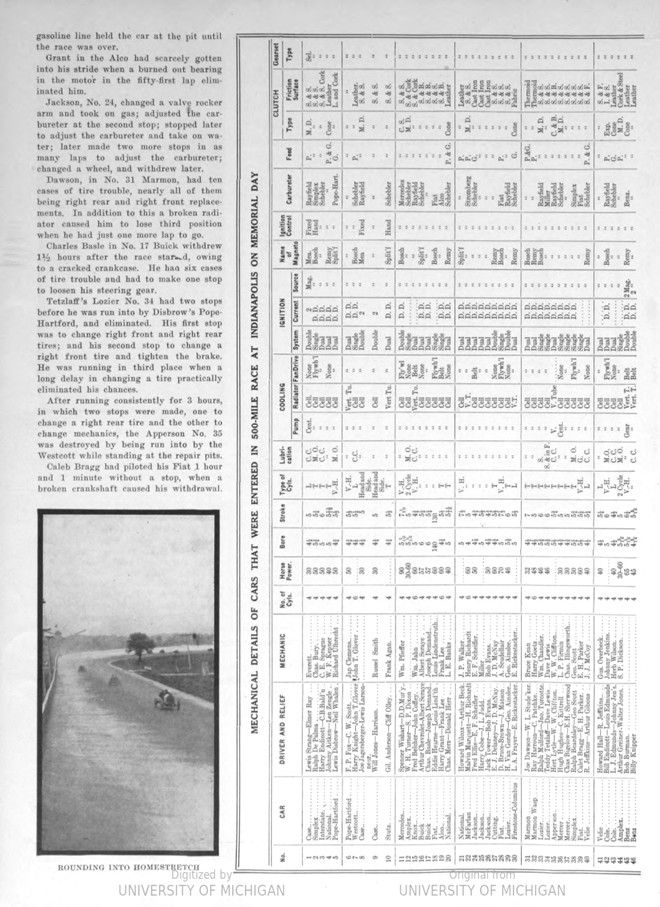
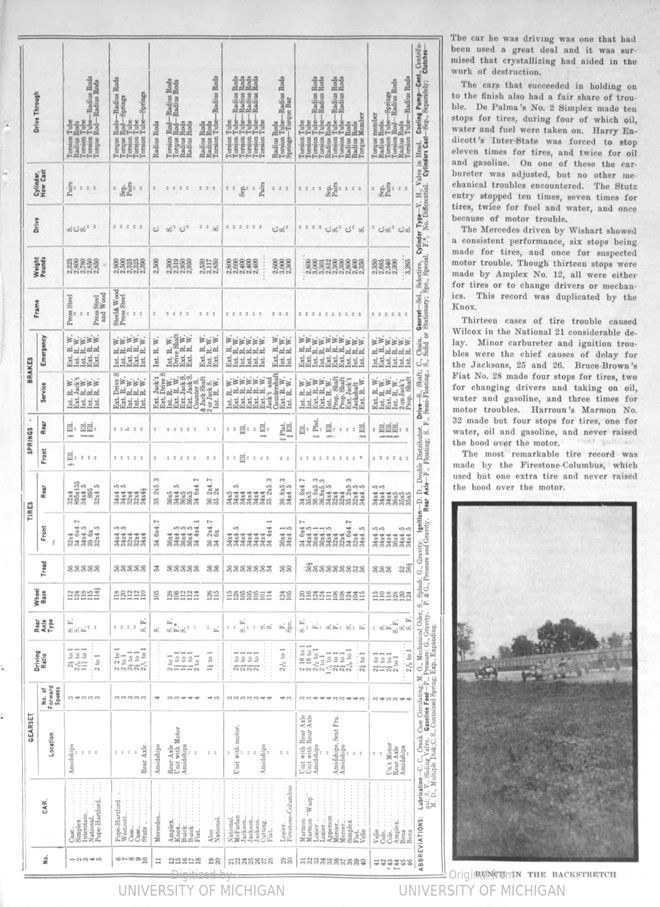
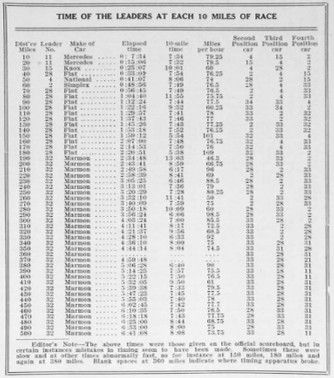
Text and jpegs by courtesy of hathitrust.org www.hathitrust.org, compiled by motorracinghistory.com
Motor Age, Vol. XIX, No. 22, June 1, 1911
Story of the Long Race From the Pits – Many Sufferers From Tire Troubles
Of the Forty Cars that Started Only Seventeen Fell By the Wayside – Troubles of Aitken, Strang, Knight, and Others Who Dropped Out – Why and When They Quit the Battle
Blowouts and Punctures Are Numerous – Broken Crankshafts Reason Some of the Cars Throw Up the Sponge – Crystallization Brings About Breakages in Steering Apparatus
OUT of the forty that started, seventeen dropped out and twenty-three were running at the finish of the race. The cars running at the finish were: Harroun’s Marmon, Mulford’s Lozier, Bruce-Brown’s Fiat, Wishart’s Mercedes, de Palma’s Simplex, Merz’s National, Turner’s Amplex, Cobe’s Jackson, Belcher’s Knox, Hughes‘ Mercer, Frayer’s Firestone-Columbus and Anderson’s Stutz, in the order named, while Bigelow’s Mercer, Burman’s Benz, Knipper’s Benz, Endicott’s Cole, Hall’s Velie, Fox’s Pope- Hartford, Adams‘ McFarlan, Hearne’s Fiat, Wilcox’s National, Delaney’s Cutting and Endicott’s Inter-State were hanging out for a chance finish to the race. Johnny Aitken’s National took the count in the one-hundred and twenty-third lap because of a broken connecting-rod. He was in eighth place at the time and running well, though he had made eight stops previously. Aitken’s first stop was made for a right rear tire after a run of 50 minutes; 1 hour and 40 minutes later another stop was made to adjust spark plugs, and six minutes later he stopped for a right front and a left rear tire and a new magneto.
Three more stops were made for right rear tires at comparatively short intervals, while water and gas were taken on 8 minutes before the connecting rod broke and put him out of the running. Disbrow’s Pope-Hartford was knocked out in the forty-fifth round, the loss of a tire causing him to skid sidewise so that he was struck broadside by Tetzlaff’s Lozier, which skidded badly in Tetzlaff’s effort to dodge him. Up to this time Disbrow had made four stops. The first one was to take off the speedometer, the cable of which was dangling; the second to adjust the carbureter; the third to replace a left rear tire and the magneto, and the fourth to replace a right rear tire.
Knight Has Trouble
Harry Knight’s Westcott met its Waterloo at the beginning of the ninety-fifth lap. Jagersburger’s car was running wild because of a broken steering gear, and the mechanic fell in trying to get out. In order to avoid running over him, Knight applied his brakes and skidded so that he lost control. The Westcott crashed into the Apperson, which had been standing at the pits for adjustments.
Jagersburger’s Case broke a steering rod in the eighty-seventh lap and was the fundamental cause of the crash between the Westcott and the Apperson. This car had been doing excellent work up to this time, having stopped only once, 2 hours and 40 minutes after the start, for oil, water and gasoline and a right rear tire.
Close Call for Strang
Strang’s Case soon after had a narrow escape from a similar cause, so the Case driven by Jones abandoned the race following an order from the company officials. Strang’s car made seven stops up to the time it dropped out. The first one was 54 minutes after the start for a right rear tire. The next stop delayed Strang a few minutes owing to the fact that a rim had become damaged by running without a tire, so that it was necessary to remove the entire wheel with a wheelpuller and replace it with a new one. The third stop was occasioned by trouble with the same tire, at which time the tanks were refilled with oil and gasoline. At 1 o’clock the fourth stop was made, at which time Strang was relieved by Ray, and a right and left front tire replaced. Three-quarters of an hour later another stop was required to replace a leaky radiator and another right front tire. The sixth stop was made at 2:27, a hole being drilled into the rear cylinder valve-chamber in an effort to stop a leak in the cylinder. When again in shape Strang chose to go as mechanician, and attempted to jump into the seat after the car had started, and was thrown to the pavement. He rose unhurt, however, and reached the seat in safety. Luck seemed to have deserted the Case outfit, however, and after a few laps more the steering rod gave out and the race was abandoned.
Arthur Chevrolet in the Buick, after burning up five tires in the first hour, was forced to give up the contest because of a broken crankshaft.
Eddie Hearne’s Benz made a short stop after a hard run of about 2 hours, at which time a shock absorber was tightened. Half an hour later the second stop was made for gasoline and oil, and Lindenstruth took the wheel. The third stop was made at 1:02 to replace a stud lost from a brace secured to the rear cylinder head, and 10 minutes after restarting, the crowd was given a thrill as the steering arm gave way on the home stretch, causing the car to run wild along the fence for about 100 feet. It was then brought to a halt within a few feet of a bridge that would have demolished the car had it been struck. The car was again brought to the pit and a new steering arm fitted after a loss of much time. Resuming the race, only two more stops were made up to the last one; one to change a right rear tire and take on water and oil and the other to change mechanics. Two hours before the race ended a broken gasoline line held the car at the pit until the race was over.
Grant in the Alco had scarcely gotten into his stride when a burned out bearing in the motor in the fifty-first lap eliminated him.
Jackson, No. 24, changed a valve rocker arm and took on gas; adjusted the cabureter at the second stop; stopped later to adjust the carbureter and take on waterr; later made two more stops in as many laps to adjust the carbureter; changed a wheel, and withdrew later.
Dawson, in No. 31 Marmon, had ten cases of tire trouble, nearly all of them being right rear and right front replacements. In addition to this a broken radiator caused him to lose third position when he had just one more lap to go.
Charles Basle in No. 17 Buick withdrew 1½ hours after the race start, owing to a cracked crankcase. He had six cases of tire trouble and had to make one stop to loosen his steering gear.
Tetzlaff’s Lozier No. 34 had two stops before he was run into by Disbrow’s Pope-Hartford, and eliminated. His first stop was to change right front and right rear tires; and his second stop to change a right front tire and tighten the brake. He was running in third place when a long delay in changing a tire practically eliminated his chances.
After running consistently for 3 hours, in which two stops were made, one to change a right rear tire and the other to change mechanics, the Apperson No. 35 was destroyed by being run into by the Westcott while standing at the repair pits.
Caleb Bragg had piloted his Fiat 1 hour and 1 minute without a stop, when a broken crankshaft caused his withdrawal.
The car he was driving was one that had been used a great deal and it was surised that crystallizing had aided in the work of destruction.
The cars that succeeded in holding on to the finish also had a fair share of trouble. De Palma’s No. 2 Simplex made ten stops for tires, during four of which oil, water and fuel were taken on. Harry Endicott’s Inter-State was forced to stop eleven times for tires, and twice for oil and gasoline. On one of these the carbureter was adjusted, but no other mechanical troubles encountered. The Stutz entry stopped ten times, seven times for tires, twice for fuel and water, and once because of motor trouble.
The Mercedes driven by Wishart showed a consistent performance, six stops being made for tires, and once for suspected motor trouble. Though thirteen stops were made by Amplex No. 12, all were either for tires or to change drivers or mechanics. This record was duplicated by the Knox.
Thirteen cases of tire trouble caused Wilcox in the National 21 considerable delay. Minor carbureter and ignition troubles were the chief causes of delay for the Jacksons, 25 and 26. Bruce-Brown’s Fiat No. 28 made four stops for tires, two for changing drivers and taking on oil, water and gasoline, and three times for motor troubles. Harroun’s Marmon No. 32 made but four stops for tires, one for water, oil and gasoline, and never raised the hood over the motor.
The most remarkable tire record was made by the Firestone-Columbus, which used but one extra tire and never raised the hood over the motor.

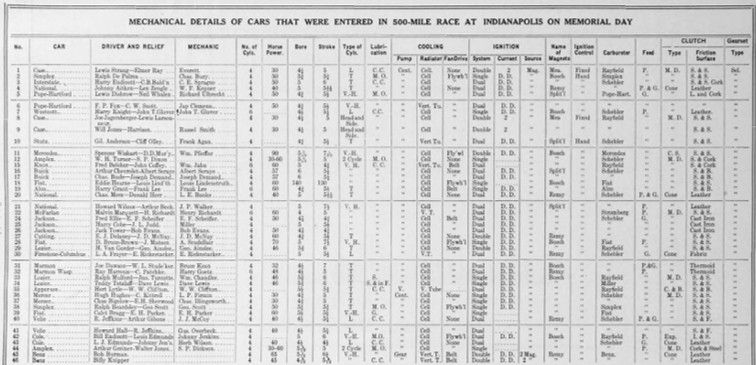
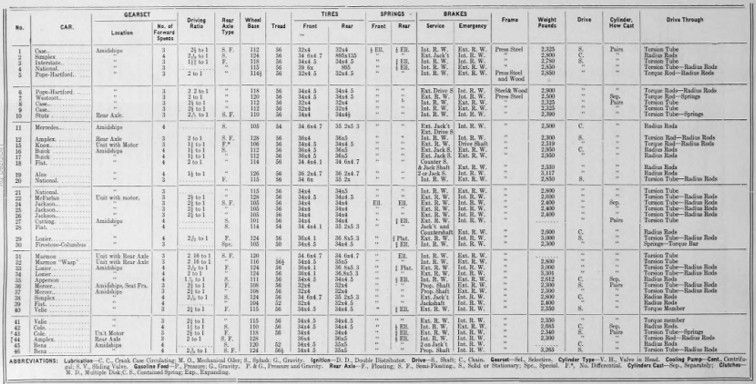
Photo captions.
Page 12 – 15
BURMAN WEARING FIRESTONE SPEED CROWN
TABLE SHOWING POSITIONS OF SOME OF THE CARS AT 10-MILE INTERVALS AS COMPILED FROM THE OFFICIAL SCORE BOARDS
TIME OF THE LEADERS AT EACH 10 MILES OF RACE
MECHANICAL DETAILS OF CARS THAT WERE ENTERED IN 500-MILE RACE AT INDIANAPOLIS ON MEMORIAL DAY BUNCH IN THE BACKSTRETCH
